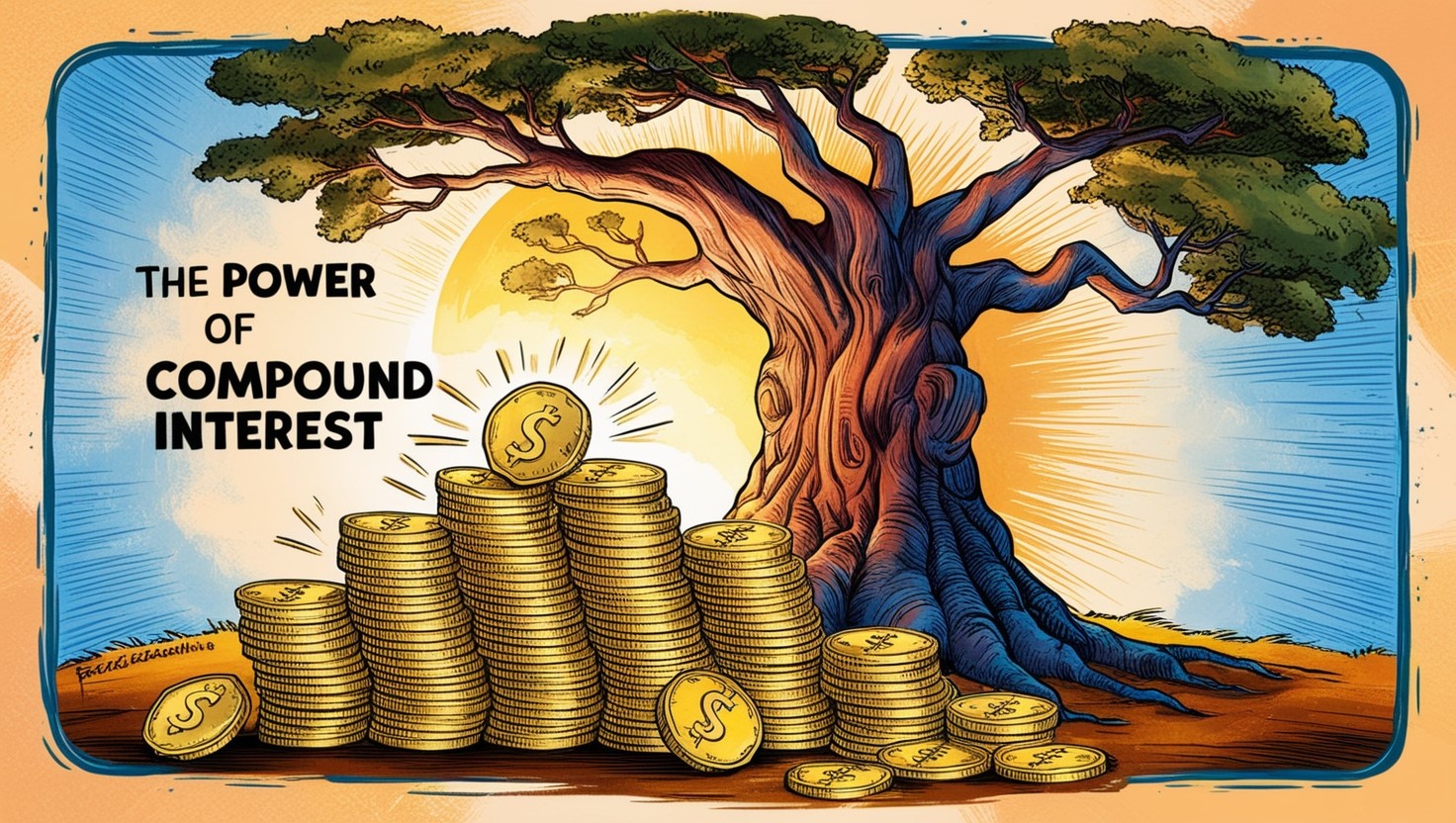IV. Look for a Margin of Safety
One of the most important principles in investing, and a core part of Phil Town’s Rule #1 philosophy, is ensuring a margin of safety. This concept, popularized by legendary investors like Benjamin Graham and Warren Buffett, refers to buying stocks at a price significantly lower than their intrinsic value. The idea is simple: by purchasing a stock at a discount, you reduce your risk of losing money while increasing your potential for long-term gains.
A margin of safety acts as a buffer in case your analysis is wrong, or the market experiences unexpected volatility. Let’s dive into what a margin of safety is, why it’s essential, and how you can calculate it using real-world examples.
1. What is a Margin of Safety?
A margin of safety is the difference between a stock’s intrinsic value and its current market price. In simple terms, it’s the cushion that protects you from mistakes in your analysis or unforeseen market downturns. By buying at a price lower than what the stock is truly worth, you give yourself a margin for error.
Think of it like buying a house that’s worth $300,000 for only $200,000. Even if something goes wrong—like a market crash or unexpected repairs—you’re still in a better position because you bought the house at a discount. In investing, this same concept applies: you want to buy stocks when they’re trading below their intrinsic value.
2. Why is a Margin of Safety Important?
The stock market can be unpredictable. Companies can face unexpected challenges, such as changes in management, new competitors, or economic downturns. By ensuring you have a margin of safety, you protect yourself from these uncertainties. If the stock market crashes or the company doesn’t perform as expected, you’re less likely to lose money if you bought the stock at a discount.
A margin of safety also allows for flexibility. Even if your calculations of a stock’s intrinsic value are off slightly, you’re still protected because you didn’t pay the full price. It’s a conservative, risk-averse strategy that helps you make better long-term investment decisions.
3. How to Calculate a Stock’s Intrinsic Value
To identify whether a stock has a margin of safety, you first need to determine its intrinsic value—the stock’s true worth based on the company’s financials and future growth potential. While there are many ways to calculate intrinsic value, one of the most common methods is the Discounted Cash Flow (DCF) model, which estimates the present value of a company’s future cash flows.
Steps to Calculate Intrinsic Value:
- Estimate the Company’s Future Cash Flows: Use the company’s historical performance to estimate its future earnings or cash flows.
- Discount the Cash Flows to Present Value: Apply a discount rate to account for the time value of money and the risks involved in the investment.
- Determine the Intrinsic Value: Sum up the discounted cash flows to get the company’s estimated intrinsic value.
4. Example: Calculating Margin of Safety for Apple (AAPL)
Let’s walk through an example using Apple (AAPL).
- Suppose after analyzing Apple’s financials, you estimate that its intrinsic value is $200 per share based on projected cash flows and growth rates.
- The current market price of Apple is $150 per share.
In this case, Apple is trading at a price below its intrinsic value, providing you with a margin of safety. If you buy Apple at $150 when you believe it’s worth $200, you have a 25% margin of safety (calculated as the difference between intrinsic value and market price, divided by intrinsic value). This buffer gives you protection if the market fluctuates or your analysis turns out to be overly optimistic.
If Apple’s growth slows or the market goes through a downturn, your investment is still more secure because you didn’t pay the full price for the stock. Essentially, you’re buying a high-quality company at a discount.
5. How Much Margin of Safety Do You Need?
The margin of safety you aim for depends on how confident you are in your analysis and how risky the investment is. Phil Town often recommends aiming for a 50% margin of safety when buying stocks. This means you’d want to buy the stock at half of its estimated intrinsic value to ensure maximum protection against risk.
Example: Tesla’s Margin of Safety
Let’s take Tesla as another example. After running your analysis, you determine that Tesla’s intrinsic value is $500 per share. However, Tesla is currently trading at $600. In this case, there is no margin of safety, and buying Tesla at this price would be risky. If anything goes wrong—whether it’s a slowdown in electric vehicle adoption or increased competition from other automakers—you could end up overpaying for the stock and facing losses.
In contrast, if Tesla were trading at $250, it would provide a 50% margin of safety, making it a much safer investment.
6. When to Apply a Margin of Safety
A margin of safety is particularly important when:
- The stock market is volatile: During market downturns or periods of high uncertainty, having a margin of safety ensures you’re protected against significant losses.
- The company’s future is uncertain: If the company operates in an industry that’s undergoing rapid changes or faces competition, a margin of safety protects you from downside risks.
- You’re less familiar with the company: If you don’t have complete confidence in your analysis, a higher margin of safety can serve as an extra buffer.
7. Real-World Examples of Margin of Safety
Example: Buying Stocks During the 2008 Financial Crisis
During the 2008 financial crisis, many high-quality companies were trading at prices well below their intrinsic value due to panic selling. Investors like Warren Buffett and Phil Town used the opportunity to buy stocks at a significant discount, ensuring a large margin of safety. For instance, Berkshire Hathaway bought shares of Bank of America and Goldman Sachs during the crisis, when these companies were undervalued. The margin of safety provided Buffett with protection in case the economy took longer to recover, while also positioning him to benefit once the market rebounded.
Example: Undervalued Stocks in 2020
Similarly, during the early stages of the COVID-19 pandemic in 2020, stocks like Disney and Airbnb saw their prices plummet as investors feared the long-term impact of the pandemic on their business models. For those who believed these companies would bounce back in the post-pandemic world, this presented a buying opportunity with a strong margin of safety. As of 2021, both companies had recovered significantly, rewarding those who took advantage of the price dip.
V. Consider the Market Trends
While analyzing a company’s fundamentals is critical to determining whether a stock is worth investing in, it’s equally important to pay attention to market trends. Market trends give you insight into the broader economic environment and can help you understand the direction in which industries or sectors are moving. However, it’s essential to distinguish between short-term market sentiment and long-term growth trends.
In this section, we’ll discuss the importance of considering market trends when evaluating a stock, how to recognize long-term trends, and how to avoid getting caught up in short-term market fluctuations.
1. Understanding Long-Term vs. Short-Term Trends
When assessing a stock’s value, it’s easy to get caught up in the day-to-day fluctuations of the stock market. However, successful investing often requires a focus on the long-term rather than the short-term.
- Short-term trends are driven by temporary factors like quarterly earnings reports, market sentiment, or news headlines.
- Long-term trends are based on fundamental shifts in technology, consumer behavior, or industry dynamics that play out over years or even decades.
Example: Amazon’s Long-Term Growth Trend
Take Amazon as an example. If you had looked at Amazon’s stock price in the early 2000s, you might have been concerned by short-term volatility. The company wasn’t making much profit at the time, and its stock price was highly volatile. However, Amazon was part of a long-term trend—the shift to online shopping—that completely transformed the retail industry. Investors who recognized this long-term trend and held onto their shares despite the short-term noise have seen massive gains over the years.
When analyzing a stock, ask yourself:
- Is the company positioned to benefit from long-term trends in its industry?
- How much of the current stock price is influenced by short-term events versus long-term growth potential?
2. Identify Sector or Industry Trends
Certain industries or sectors experience growth due to broader economic, technological, or societal changes. Identifying these sector trends can help you find stocks that are poised to grow along with the market.
Example: Renewable Energy Sector Growth
One significant trend in recent years is the global shift toward renewable energy. Governments and corporations are investing heavily in clean energy solutions like solar, wind, and electric vehicles as part of efforts to combat climate change. Companies in the renewable energy sector, such as NextEra Energy or Tesla, have benefited from this trend. Investors who recognized the long-term growth potential of clean energy early on are now seeing the rewards as these companies continue to grow and innovate.
When looking for industry trends, consider:
- Are there technological advancements or regulatory changes driving growth in the sector?
- Is consumer demand increasing for the products or services offered by companies in this industry?
- How will the industry look in 5 or 10 years, and is the company positioned to benefit from this shift?
3. Avoid Getting Caught Up in Market Sentiment
Market sentiment refers to the overall mood or attitude of investors at a given time. Sentiment can cause stock prices to swing wildly based on fear, greed, or excitement. While market sentiment can create buying opportunities, it can also lead to poor investment decisions if you let short-term emotions dictate your strategy.
Example: The Dot-Com Bubble
A classic example of market sentiment going wrong was the Dot-Com Bubble in the late 1990s. During this time, investors were swept up in the excitement around internet companies, leading to sky-high stock valuations for companies with little or no revenue. When the bubble burst in 2000, many of these companies collapsed, and stock prices plummeted. Investors who got caught up in the hype and failed to consider the fundamentals of the companies they were investing in faced significant losses.
Example: Meme Stocks and GameStop
More recently, the GameStop short squeeze in early 2021 showed how market sentiment, driven by online communities and social media, can cause massive price fluctuations in a short period. GameStop’s stock price soared as retail investors drove up the price, but many investors who bought in at the peak lost money when the stock eventually came crashing back down. This highlights the danger of following short-term trends driven by sentiment rather than fundamentals.
To avoid getting caught up in market sentiment:
- Focus on the company’s long-term potential rather than daily price movements.
- Be cautious when investing in companies that are experiencing a sudden surge in popularity without strong fundamentals to back it up.
- Look for companies with solid business models that can weather short-term market volatility.
4. Recognize Cyclical Trends
Some industries and stocks are cyclical, meaning they are more sensitive to changes in the broader economy. Cyclical stocks tend to rise and fall with economic cycles—booming during periods of economic growth and struggling during recessions.
Example: The Auto Industry
The automotive industry is a great example of a cyclical sector. During economic expansions, consumers are more likely to buy new cars, which drives up the stock prices of automakers like Ford or General Motors. However, during economic downturns, demand for new vehicles tends to fall, which can hurt these companies’ earnings and cause their stock prices to drop.
As an investor, it’s important to recognize these cyclical trends and adjust your strategy accordingly:
- Are you investing in a cyclical industry? If so, is it in an expansion or contraction phase?
- How well is the company positioned to survive an economic downturn?
- Are you prepared for potential volatility in the stock price due to economic cycles?
5. Leverage Market Corrections
One of the most powerful aspects of long-term investing is the ability to capitalize on market corrections. During periods of market fear or uncertainty, stock prices may drop significantly—even for companies with strong fundamentals. Savvy investors can use these opportunities to buy high-quality stocks at discounted prices.
Example: Buying During the 2020 Market Crash
During the early stages of the COVID-19 pandemic in 2020, global stock markets experienced one of the fastest declines in history. However, companies like Apple, Microsoft, and Amazon quickly rebounded as investors recognized their long-term growth potential, even in a pandemic-stricken world. Those who bought shares during the market dip in March 2020 have since seen significant gains, proving the value of buying during corrections.
When looking to leverage market corrections:
- Focus on high-quality companies with strong long-term fundamentals that are temporarily undervalued.
- Be patient and wait for opportunities to buy stocks at a discount during market downturns.
- Avoid panic selling when markets are volatile—stick to your long-term strategy.
6. Global Market Trends
Finally, consider global trends that can impact your investment decisions. Factors like international trade, geopolitical events, and global economic shifts can have significant effects on industries and companies worldwide. Companies that operate internationally or rely on global supply chains are especially sensitive to these trends.
Example: China’s Growing Middle Class
One global trend that has benefited companies like Nike and Starbucks is the rapid growth of the middle class in countries like China. As disposable incomes rise, demand for consumer goods, luxury items, and Western brands has increased significantly. Companies that recognized this trend early on and expanded their presence in China have enjoyed strong growth as a result.
When considering global trends, think about:
- How do international markets and economies affect the companies you’re investing in?
- Are there geopolitical risks or opportunities that could impact the company’s long-term performance?
- Is the company positioned to take advantage of global economic shifts, such as emerging markets or technological advancements?
VI. Make the Investment Decision
After analyzing a company’s business model, financial health, competitive moat, and market trends, it’s time to pull the trigger and make the investment decision. This is where all your research comes together, and you must decide if the stock fits within your investment strategy. But even with all the data in front of you, this step can feel daunting—especially when money is on the line. Let’s break down how to make a smart, informed investment decision, with examples to guide you through the process.
1. Review the Company’s Fundamentals
Before you make your final decision, take a step back and review the fundamentals of the company. This is where you evaluate all the data you’ve gathered and ensure the company is financially strong, has a durable moat, and aligns with market trends.
Example: Google (Alphabet)
Let’s say you’ve done your research on Google (Alphabet). You’ve analyzed its financials and see that it has strong revenue growth, robust earnings, and an enormous cash reserve. Google also has an impressive moat, with its dominance in online search, YouTube, and digital advertising, making it hard for competitors to catch up. Additionally, you see that Google is well-positioned to benefit from long-term trends like the growth of digital marketing and cloud computing. Based on these fundamentals, Google looks like a solid investment.
When reviewing the fundamentals, ask yourself:
- Is the company’s business model sustainable?
- Are the financials strong and trending in the right direction?
- Does the company have a durable competitive advantage?
- Is the company positioned to benefit from long-term market trends?
2. Confirm the Margin of Safety
Next, ensure that you’re buying the stock with a margin of safety. This means the stock is trading at a price significantly below its intrinsic value, providing you with a cushion in case your analysis is wrong or the market takes a downturn.
Example: Coca-Cola
Suppose after running your discounted cash flow analysis, you estimate Coca-Cola’s intrinsic value to be $70 per share. The stock is currently trading at $50 per share, giving you a margin of safety of 28%. This buffer reduces your risk and allows you to buy a high-quality company at a discount. If your calculations are slightly off, or the market experiences volatility, you still have room to protect yourself from significant losses.
When confirming your margin of safety, think about:
- Am I buying this stock at a discount to its intrinsic value?
- Do I have a buffer that protects me from unforeseen risks?
- How confident am I in the valuation and the company’s ability to grow?
3. Consider Your Investment Time Horizon
When making an investment decision, it’s essential to consider your time horizon. Are you investing for the long term, or are you looking for short-term gains? For most value investors like Phil Town, the focus is on long-term wealth creation. This means buying stocks with the intention of holding them for at least five to ten years, or until the company’s fundamentals change.
Example: Amazon’s Long-Term Horizon
Think about investors who bought Amazon in the early 2000s. Despite short-term volatility and skepticism about Amazon’s profitability, those who recognized the long-term trend of e-commerce and held onto their shares saw massive gains over time. While Amazon’s stock price experienced fluctuations, the company’s underlying business model and growth prospects remained strong. Investors who were patient and focused on the long-term were handsomely rewarded.
When considering your time horizon, ask:
- Am I prepared to hold this stock for the long term, even if there are short-term market fluctuations?
- Do I believe the company’s growth prospects will continue for several years?
- Is this investment part of a long-term wealth-building strategy?
4. Evaluate the Company’s Risks
No investment is without risks. It’s important to acknowledge the potential downsides and make sure you’re comfortable with them before investing. This doesn’t mean avoiding risk altogether, but rather ensuring the risks are manageable and the potential rewards outweigh them.
Example: Tesla’s Risk vs. Reward
Tesla is a company with huge growth potential, but it also comes with considerable risks. While Tesla dominates the electric vehicle (EV) market and has significant first-mover advantages, it faces risks from competitors, supply chain disruptions, and evolving government regulations around clean energy. If you’re considering investing in Tesla, you must weigh these risks against the potential upside of a world that is increasingly moving toward EVs.
When evaluating risks, consider:
- What are the major risks facing this company (competition, regulatory, economic)?
- How well is the company positioned to handle these risks?
- Am I comfortable with the level of risk, given the potential reward?
5. Align the Investment with Your Financial Goals
Every investment should align with your personal financial goals. Whether you’re looking to build long-term wealth, generate passive income, or diversify your portfolio, make sure that this investment fits within your broader financial strategy.
Example: Dividend Stocks for Passive Income
If your goal is to generate passive income, you might look at dividend-paying stocks like Johnson & Johnson or Procter & Gamble. These companies have a long history of paying consistent dividends, making them attractive options for investors who want a steady income stream. If your primary goal is income rather than growth, dividend stocks may be a better fit than high-growth companies like Tesla or Amazon, which reinvest most of their earnings back into the business rather than paying out dividends.
When aligning the investment with your goals, ask:
- How does this investment fit into my overall financial strategy?
- Does it help me achieve my short-term or long-term financial goals?
- Am I looking for growth, income, or a balance of both?
6. Make the Purchase with Confidence
Once you’ve reviewed the company’s fundamentals, confirmed the margin of safety, considered the time horizon, evaluated the risks, and aligned the investment with your goals, it’s time to make the purchase with confidence. Keep in mind that no investment is risk-free, but by following a disciplined process, you’ve minimized your chances of making a poor decision.
Example: Making a Confident Decision with Apple
Let’s say after completing your research, you decide to invest in Apple. You believe in the company’s long-term growth potential, its financial strength, and its competitive moat. Apple is trading at a price that provides a decent margin of safety, and you’re comfortable holding the stock for at least five to ten years. With all your research backing your decision, you make the investment confidently, knowing you’ve done your homework.
When making the purchase, remember:
- Stick to your research and avoid letting emotions dictate your decision.
- Don’t worry about trying to time the market perfectly; focus on the company’s long-term prospects.
- Stay disciplined and patient—investing is about making smart decisions, not reacting to short-term market movements.
7. Monitor the Investment, but Don’t Panic
After making the investment, your work isn’t done. You’ll want to monitor the company’s performance and keep an eye on any major changes in its fundamentals or the market environment. However, it’s important to avoid checking the stock price daily or panicking over short-term volatility. Successful investors remain calm and focus on the long-term picture.
Example: Holding Through Market Corrections
In March 2020, during the COVID-19 pandemic, the stock market saw one of the fastest declines in history. Many investors panicked and sold their shares, but those who remained calm and focused on the long-term potential of companies like Microsoft and Disney were rewarded as the market quickly rebounded. Investors who stuck to their investment strategy and avoided panic-selling emerged with significant gains.
When monitoring your investment, remember:
- Check in on the company’s financial reports, earnings calls, and major news, but avoid overreacting to short-term price movements.
- Keep an eye on any changes in the company’s fundamentals, such as declining revenue, increased debt, or loss of competitive advantage.
- Stay patient—long-term investing is about time in the market, not timing the market.
Final Thoughts
Investing can often seem intimidating, but by following a clear, disciplined process, you can make informed decisions that set you up for long-term success. The key is to focus on the fundamentals—understand the business, assess its financial health, ensure it has a competitive moat, and look for a margin of safety. Along the way, keep an eye on market trends without letting short-term volatility distract you from the bigger picture.
Remember, successful investing isn’t about finding the next big thing or timing the market perfectly—it’s about making smart, long-term decisions based on solid research. Companies with strong fundamentals, durable moats, and favorable market positioning are the ones that will continue to grow and reward patient investors.
By following these steps, you can make confident investment decisions that not only protect your hard-earned money but also grow it over time. Stay patient, stay disciplined, and trust the process. Investing is a journey, and with the right approach, you’ll be well on your way to achieving your financial goals.



